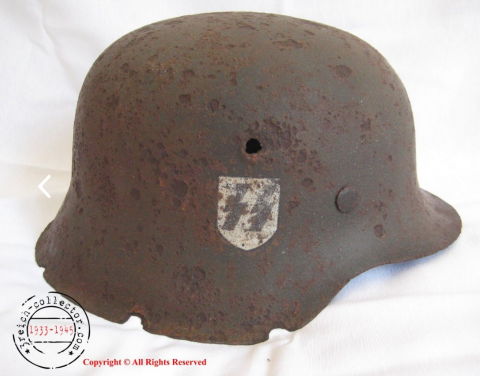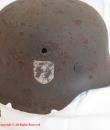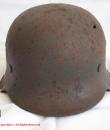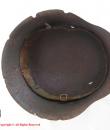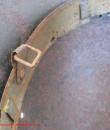Really impressive awesome condition SS single decal M42 helmet recovered in Cherkassy pocket battle area, found in Leibstandarte SS Adolf Hitler positions with ID tag of the same division (ID tag not included)!
| Price: | $1,350.00 |
We offer you the chance to get a true piece of history! It's a really impressive and complete relic condition helmet with the 90% of the SS decal still attached! Helmet shell is solid and no pirces come off from it, with only some minor holes but still with original feldgrau paint there! It's a M42 single decal SS helmet and although leather is lost, the liner is still inside the shell. This helmet was found in the Korsun-Cherkassy pocker battle area, where the famous battle took place during the Dnieper-Carpathian Offensive on the Eastern Front during World War II. It was found along with Leibstandarte Adolf Hitler SS Panzer division ID tag, so it's 100% possible that it belonged to a LSSAH division soldier, the elite within the Waffen SS! Recovered with a metal detector and cleaned with oxalic acid to remove all the oxid and bring it to the original condition, it was also treated with electrolisis process to avoid the oxidation of the shell, so it's guaranteed that helmet won't deteriorate in the future. Decal is awesome and helmet is gorgeous to be displayed in a cabinet along with other SS items. The Korsun-Shevchenkovsky Offensive led to the Battle of the Korsun–Cherkasy Pocket which took place from 24 January to 16 February 1944. The offensive was part of the Dnieper–Carpathian Offensive. In it, the 1st and 2nd Ukrainian Fronts, commanded, respectively, by Nikolai Vatutin and Ivan Konev, encircled German forces of Army Group South in a pocket near the Dnieper River. During weeks of fighting, the two Red Army Fronts tried to eradicate the pocket. The encircled German units attempted a breakout in coordination with a relief attempt by other German forces, resulting in heavy casualties, estimates of which vary. The Soviet victory in the Korsun-Shevchenkovsky Offensive marked the successful implementation of Soviet deep operations. Soviet Deep Battle doctrine envisaged the breaking of the enemy's forward defences to allow fresh operational reserves to exploit the breakthrough by driving into the strategic depth of the enemy front. The arrival of large numbers of American- and British-built trucks and halftracks gave the Soviet forces much greater mobility than they had before. This, coupled with the Soviet capacity to hold large formations in reserve gave the Red Army the ability to drive deep behind German defenses again and again. Though the Soviet operation at Korsun did not result in the collapse in the German front that the Soviet command had hoped for, it marked a significant deterioration in the strength available to the German army on that front, especially in heavy weaponry, nearly all of which was lost during the breakout. Through the rest of the war the Red Army would place large German forces in jeopardy, while the Germans were stretched thin and constantly attempting to extract themselves from one crisis to the next. Mobile Soviet offensives were the hallmark of the Eastern front for the remainder of the war. RCV
